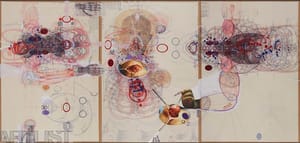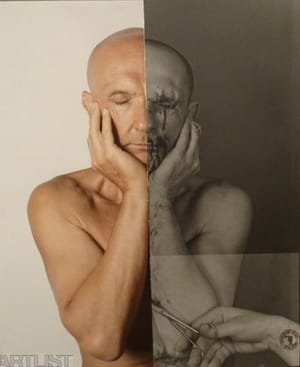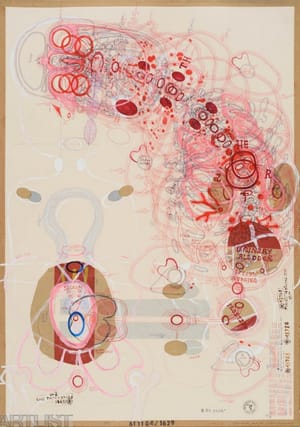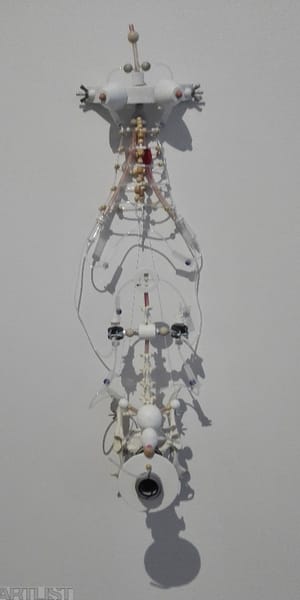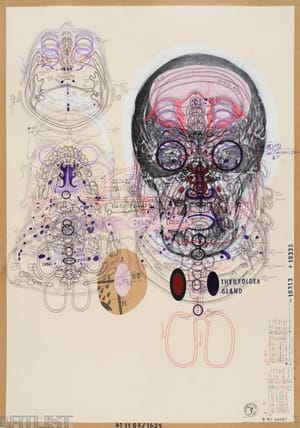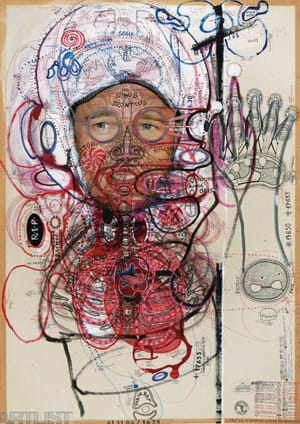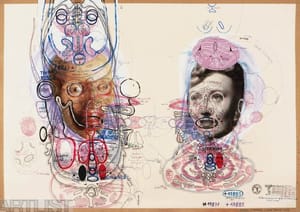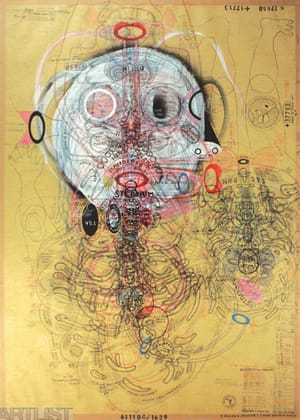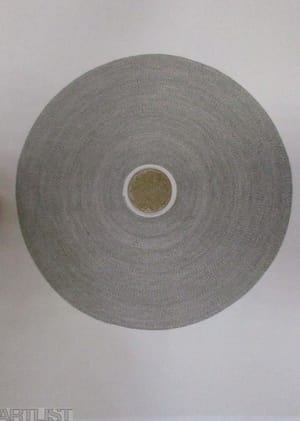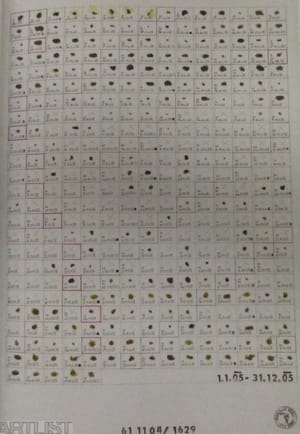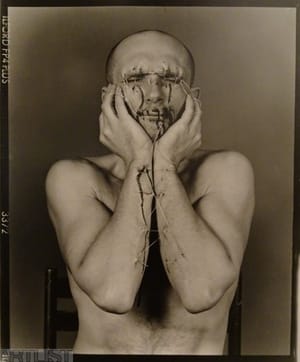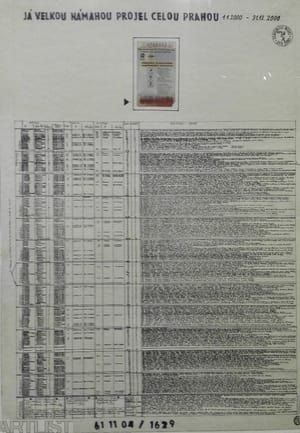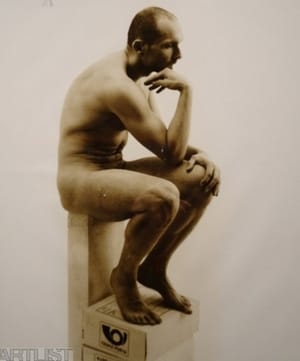- First Name
- Luboš
- Surname
- Plný
- Born
- 1961
- Birth place
- Česká Lípa
- Place of work
- Praha
- CSU Library
- ↳ Find in the catalogue
About artist
The work of autodidact Luboš Plný, usually classified as art brut, contains several elements ranging from conceptual art and performance to painting, drawing, collage and object sculpture. The main feature of his work in many of these media is an almost manic obsession with his own body and life. One of his outputs is his life journal, in which he records his entire life, day-by-day, using small artefacts, newspaper clippings and texts. In fact, most of his works have the character of a diary.
Even as a child Plný had been attracted to the fine arts, but never studied them. He did various different jobs, and often made a living as an electrician. Under the influence of his own psychological problems, which led to hospitalisation and a diagnosis of simple-type schizophrenia, he began to study intensely psychiatric and medical literature. He moved to Prague in the latter half of the 1980s, where he applied several times to the Academy of Fine Arts. Having failed the entrance examinations he decided to get into the school in a roundabout way, and this is basically how his career in art began.
In 1989 he worked at the Academy as a model for life-drawing classes. He viewed his six-year stint as an art project, at the end of which he would be awarded the title of “academic model”, which he duly received in 2000. His request for a title that had not until then ever existed was accompanied by letters by artists (Tomáš Smetana, Igor Korpaczewski), psychological assessments, and photographs in which he put himself into the same positions as we see in famous works from art history, e.g. the ancient Discobolus, Michelangelo’s David and Rodin’s The Thinker. As the last part of the project suggests, as a model at the Academy Plný conceived of himself as the embodiment of an artwork.
Further conceptual projects followed that were played out over the long-term. Unlike the path to the title from the Academy, there is an element of time-lapse involved, as well as a kind of intimacy, since the only actor is Plný, who is also the only person who knows what is happening. This applies to the projects Pupíkový deník / Bellybutton Diary of 1996 and Der Schwarze Reiter of 2000. In the first project every day of the year he collected the remnants of cloth and hair that had gathered in his belly button. These were subsequently glued to paper with the exact date when they were collected. Here too evidence of Plný’s obsessiveness is present in the fact that he recorded and dated not only life events, but also things that might appear futile. Plný also gives weight to the fragments of dirt he wipes from his body, because using them he can recognise what colour t-shirt he had on that day or what the weather was like. In Der Schwarze Reiter he travelled on Prague public transport for a year without paying. In order that the event not simply fizzle out, he wrote Prague Public Transport a letter in which he called for his own “capture” with the wish that a photo of him be hung in the metro with the word WANTED underneath. He documented the entire event in detail, including where he travelled from and how often he met ticket inspectors.
Plný is fascinated by physicality, both his own and corporeality in general. He has undergone various treatments, from the psychiatric to therapy for insomnia to an operation on his thyroid gland that he again carefully documented using photographs and notes. Under the influence of medical facilities and the study of anatomical atlases he arrived at an artistic style that brought him world renown. He adopted the aesthetic of medical textbooks and anatomical self-portraits form a central part of his work. As well as the diary-like element to his work, a fact evident in the numerical titles that refer to how many days a drawing lasted and what day it was completed, it also has a therapeutic function. Coloured ink drawings combined with collage and acrylic painting are executed with great precision and, in addition to details of the human organism, the skeletal system, digestive tract and venous system also contain Latin terminology. The resulting multilayered horizontal sections of organs, muscles and bones are supplemented with texts describing the events that took place while Plný was working on the drawing.
His interest in everything physical, including body-related processes such as pain and aging, along with his obsessive recording of time, culminated in the project Sešívané fotografie / Stitched Photographs of 2016. Plný returned to a bodyart event from 2003 recorded in photographs, during which he had sewn his face with coarse thread. Thirteen years later he was photographed in the same positions with the identical facial expressions, and then stitched photographs from the different time periods together.
Another aspect of Plný’s work that does not quite seem to fit in are 3-dimensional objects created from everyday household items or found objects (plumbing pipes, tools, components, pieces of wood or metal, medical materials, antlers). In the series Erotické hračky / Erotic Toys he combines these items in order to create fetishistic objects referring to human organs, such as Žena / Woman (2012), which has the shape of a uterus. The aesthetic of these works hints at both sadomasochistic salons as well as a ritualistic, magical character that is present in Plný’s work, above all in the anatomical drawings.
Thanks to his life story and the growing popularity of art brut, Plný made a name for himself on an international level. This culminated in the exhibition Viva Arte Viva!, part of the Venice Biennale (2017). In the same year a documentary about him was filmed as part of the series Orbis artis directed by Jaroslav Brabec. At the turn of 2017–2018 a retrospective of his work entitled Viva Luboš Plný! was held at DOX, Prague.
- Author of the annotation
- Zuzana Krišková
- Published
- 2018
CV
Exhibitions
- Solo exhibitions
-
2018
Čekárna, Galerie Pro Arte, Praha
2017–2018
Viva Luboš Plný!, DOX, Praha
2017
*13677 +20242, Artinbox Gallery, Praha
2007
Body Electric, Cavin-Morris gallery, New York, USA
2002
Zuby jsou bezvadný, ale dásně budou muset ven, Galerie Millennium, Praha
1993
Zachovalé ostatky, Galerie Affa, Praha
1988
Kamuchláže, Okresní vlastivědné muzeum, Česká Lípa
- Group exhibitions not included in ARTLIST.
-
2017
Biennale Arte, Benátky, Itálie
2016
Connected, Centrale for contemporary art, Brusel, Belgie
2015
Art Brut Live!, DOX, Praha
Draw, The Centrale for Intuitive and Outsider Art, Chicago, USA
2014
Art brut masterpieces and discoveries, Galerie Christian Berst, Paříž, Francie
Art brut – collection abcd/Bruno Decharme, La Maison Rouge, Paříž, Francie
2013
Kdo lže, krade…? Aneb jak zvítězit nad lží a nenávistí, Artinbox Gallery, Praha
2011
Anatomia Metamorphosis, Museum Montanelli, Praha
2010
The weight body, Museum Dr. Guislain, Gent, Belgie
2009
Plant Body, Animal Body, Cavin-Morris Gallery, New York, USA
Anna Zemankova & Lubos Plny, abcd la galerie, Montreuil, Francie
2008
New Views, Re-Views, Cavin-Morris Gallery, New York, USA
2007
Umění porodit, Veletržní palác, Praha
2006
Art brut. Sbírka abcd, Dům U Kamenného zvonu, Praha
2005
System In Chaos, Cavin-Morris Gallery, New York, USA
2003
Monstra a monstra v nás, Galerie Millennium, Praha
2003
Das endlose Rätsel. Dalí und die Magier der Mehrdeutigkeit, Museum Kunstpalast, Düsseldorf
- Collections
-
Abcd, sbírka Bruno Decharma, Francie
Centre Pompidou, Francie
Museum of Everything London, Velká Británie
Galerie Artinbox, Praha
Nadace DrAK, Praha
Monography
- Monography
ZEMÁNKOVÁ T./ŠAFÁŘOVÁ B.: Art brut-Luboš Plný, katalog výstavy, Muzeum Montanelli, Praha 2011
CORNEVIN E./DVOŘÁK V.: Monstra a monstra v nás, katalog výstavy, Galerie Milennium, Praha 2005
JAROLÍMEK M. (ed.): Chvála bláznovství 4: Luboš Plný, Silvie Vurcfeldová, Boris Škil, Jan Holub, Markéta Kolářová, katalog výstavy, Galerie Millennium, Praha 2003
- Articles
ZEMÁNKOVÁ T.: Akademický model, in: Art and Antiques, č. 7-8, 2017, str. 62-65
